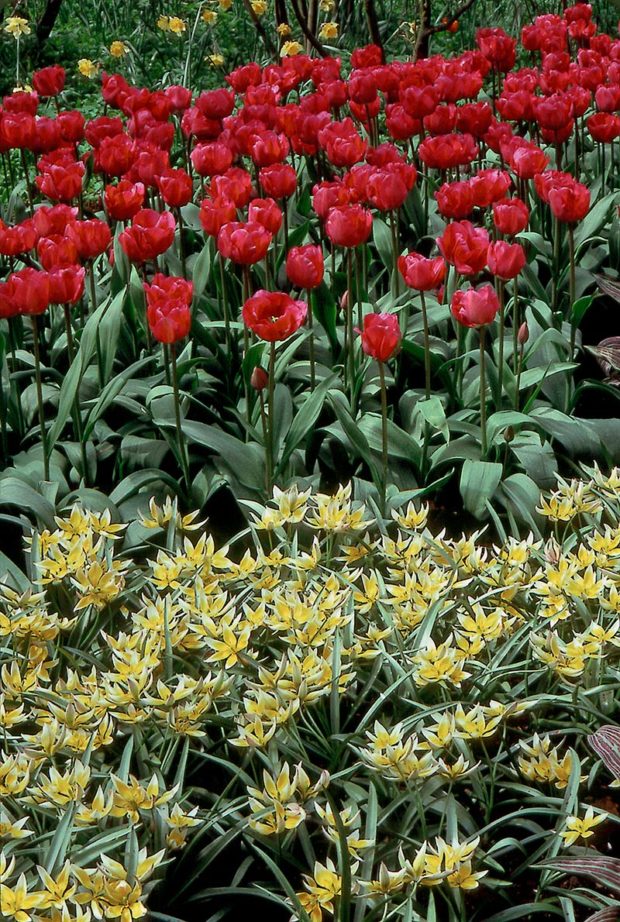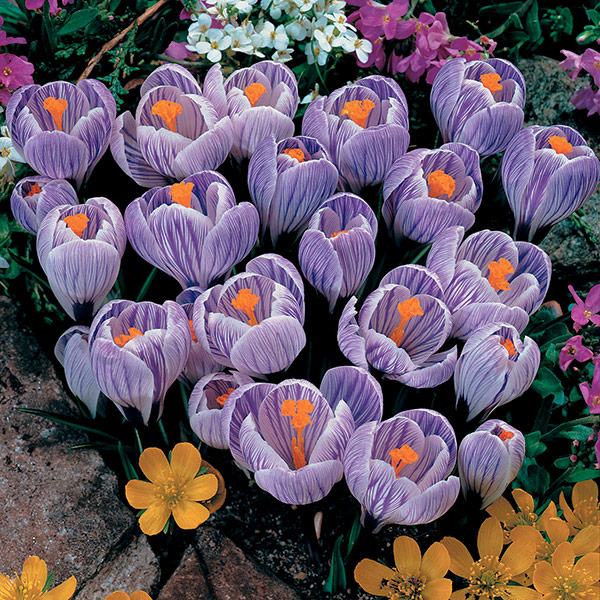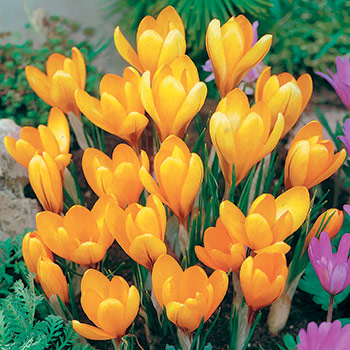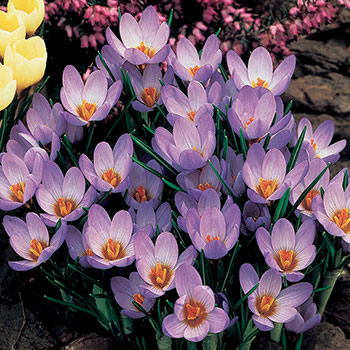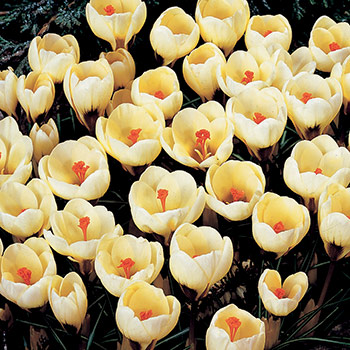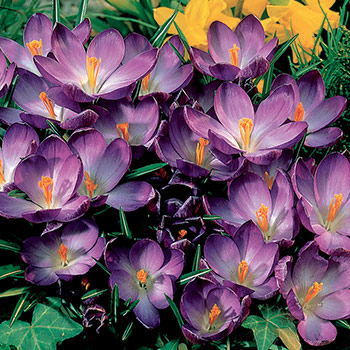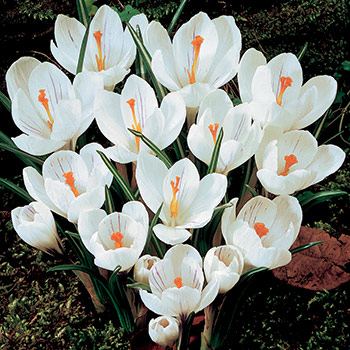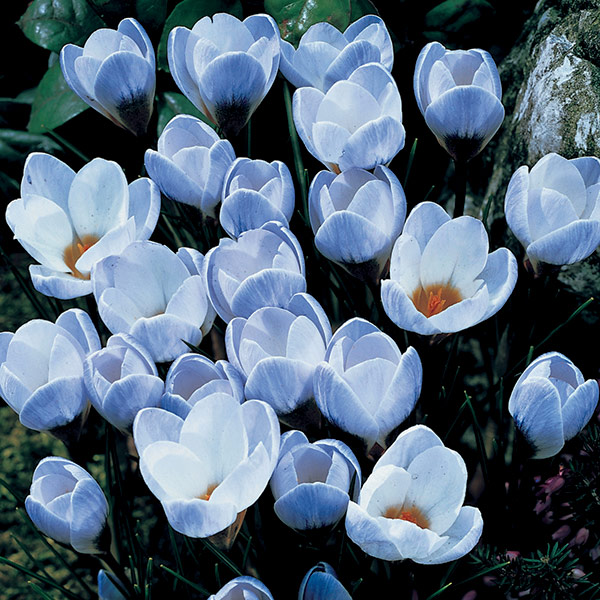Bulbs come up too early
If you want to avoid this problem, plant bulbs deep and don’t plant right next to a sunny south wall.
Bulb foliage may emerge during an extended winter thaw, or come up far enough during an early spring heat wave that we worry it will freeze when normal temperatures return. Relax. That plant may lose leaf tips to the cold, but it’s no big loss. A fully grown tulip or daffodil leaf may be 12 inches long. If it loses an inch at the tip—that part which sits above the zone protected by radiant heat from the soil—the remaining 11 inches is enough to fuel the plant’s growth and bloom.
A hard freeze can hurt if it comes after your bulbs’ flower buds emerge. If a hard freeze is forecast, you can cover bulbs with floating row cover cloth or newspaper to trap ground heat, or run sprinklers during the coldest hours to protect the plants via heat released by cooling water.
Some bulb species are prone to early growth (Dutch iris is an example). If you see a bulb act this way in your garden every year, don’t plant that species or variety anymore. Also, some places are more likely than others to heat up early. Beds along south-facing brick walls are at risk, as are sandy beds that slope south. Recognize these places and don’t grow bulbs there. Finally, some practices contribute to early rising. The most common is too-shallow planting.
Bloom one year, never again
Avoid this by planting your bulbs in full sun this fall. Where it’s already a problem, make site changes to let in more light or move the bulbs.
Most often, failure to bloom means a site is too shady. To flower, most spring bulbs need at least six hours of sun while their leaves are green. Given that, embryonic flower buds form in the bulb this summer to bloom next spring. New bulbs coming from a sunny bulb production field may have enough stored energy to bloom their first spring even in shade. From then on, it’s all downhill.
Shallow planting and summer moisture can also contribute. This is especially true of bulbs that have a tunic (a paper-like covering), such as tulips, daffodils, crocus, and gladiolas. Tunicate bulbs require hot, dry summers. When these bulbs are too cool or moist during summer, they may not form flowers.
The stems flop over before the plants bloom
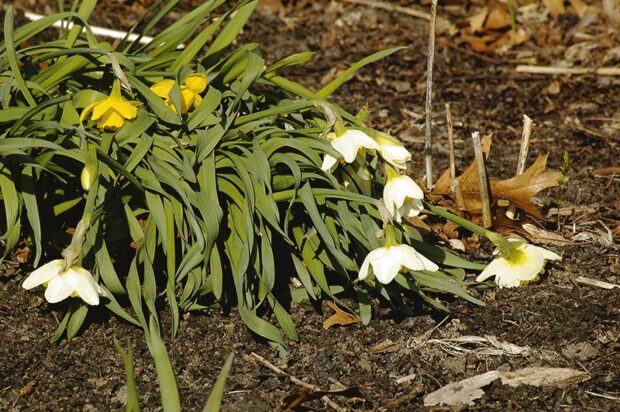
In answer to this problem, select sunny spots for your bulbs, keep those beds well watered this fall and again next spring as the bulbs emerge, and use only slow-release fertilizers.
For example, daffodils might have stems that are not strong enough to support the weight of the flower. They either lean over from the base or bend right in the middle of the stem. On the double-flowered varieties, the weight of the bloom may cause the stem to break.
Weak stems are often the result of planting where there is too much shade. For example, daffodils need at least eight hours of sunlight to perform well. When the area is too shady, they often stretch to reach the sun, causing their stems to elongate and become weak.
As far as nutrition is concerned, “balanced” fertilizer is another possible culprit. Daffodils need a slow-release nitrogen in smaller quantities. Too much nitrogen will cause the bulbs to produce lots of weak, green leaves at the expense of blooms. The addition of more potash (potassium) will help produce stronger bulbs, which develop stronger leaves and stems.
Sufficient moisture is critical to daffodils—in the fall to help generate good roots before the ground freezes and again in the spring when the flowers are actively growing. Daffodil stems are hollow and when there is enough moisture, the stem is filled with water, which helps to support itself and the flower. If it’s dry and the stem is hollow, it is more likely to buckle under the weight of the flower.
Leaves emerge fine but quickly discolor and die
Let it be a lesson this fall: If drainage is not perfect, don’t plant bulbs there.
In these cases, the plant also fails to bloom. Bulb rot is often the cause, and poor drainage is the most common contributor to rot. Dig out the suspect bulbs. If the bulbs or roots are discolored and have soft or foul-smelling areas, dispose of them in a hot compost or by burning. Improve the drainage in that area, raise the bed, or switch to plants more tolerant of wet soil. For instance, quamash (Camassia) is generally more tolerant of moisture than tulips.
Failure to exit gracefully
Plan in the fall for a better ending to next spring’s show.
Gardeners love bulbs’ spring show but often hate the clutter factor—the leaves’ prolonged fade. Yet foliage can be clipped away earlier than you may think, if a plant is already full enough. If all you ask is that a plant replace itself each year, not increase its clump size, cut back tulip and daffodil foliage as early as June 1—about two months after the plants emerge from winter rest. If such plants don’t bloom as well the next year, stall that year’s cut by two weeks or replace them with a variety that can put up with our impatient ways.
However, it is simplest to let bulb foliage die back naturally. You can allow this yet reduce the visual distraction by pairing bulbs with late-emerging perennials such as hardy hibiscus (Hibiscus moscheutos) or blue mist flower (Conoclinium coelestinum), or self-sowing annuals such as balsam (Impatiens balsamina) or spider flower (Cleome).

Article by Janet Macunovich and photos by Steven Nikkila, www.gardenatoz.com.
RELATED: Proper planning ensures reliable spring bulbs
ELSEWHERE: Naturalizing spring flowering bulbs

